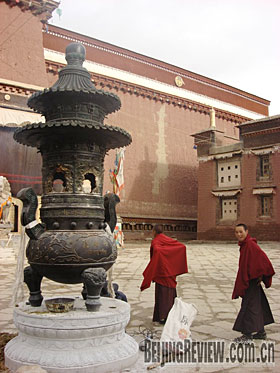|
Toinzhub, 65, visits Sakya Monastery whenever he feels like to talk to Buddha. "Although the monastery is smaller than it used to be when I was a kid, it looks more beautiful and sacred than before," he said. Pointing to the murals, he said he could hardly imagine the faded colors could return to their original glow. Toinzhub said it is now more convenient to travel to the Monastery as the road is better.
 |
|
SIGN OF THE TIMES: Monks in Sakya Monastery have embraced the restorative changes that have taken place for the past six and a half years (XINHUA) | The 21-year-old girl Yexei was circumambulating the monastery carrying her niece on her back. She told Beijing Review that she was taken to the monastery when she was born, and visited the holy place at least once each year. In this visit, she prayed for the health of her parents and safety of all her family. "At present, I can pray at more places than I used to. We were all excited to hear about the repair work in 2002 and have witnessed the big changes each year," Yexei said.
Palden Donyus, Abbot of Sakya Monastery, confirmed that in peak periods, more than 10,000 people visited Sakya Monastery in a single day.
"More tourists from the foreign countries as well as Taiwan and Hong Kong are coming to visit the Monastery," he said.
The abbot also said that about 10 years ago when he was studying in Beijing, there were few people who believed in Tibetan Buddhism. On his return five years later he was surprised to find many people with some knowledge of Tibetan Buddhism.
"Some people even walked up to me in the street and asked questions about our religion after seeing I was wearing [monk's] robes," he said.
He thinks that in developed cities like Shanghai, Shenzhen and Beijing, people have less economic worries and start to have more time to follow spiritual pursuits. Tibetan Buddhism is a perfect match for their desire to find peace of mind and learn about love and compassion, he said.
As the "Three Cultural Relic" repair work comes to a close, the Central Government decided in April 2008 to invest another 570 million yuan ($83 million) in its "11th Five-Year Plan (2006-10)" in restoring and repairing 22 of the cultural relics in Tibet. Up till now, over 1,400 monasteries, cultural relics, and religious activity sites have been restored and opened to the public. From 1978 till 2010, the government will have invested an aggregate amount of 1.2 billion yuan ($175 million) in protecting and repairing cultural relics in Tibet.
|
Sakya Monastery Facts
The history:
The Sakya Monastery is the ancestral temple of the Sakyapa sect of Tibetan Buddhism. It was built in 1073 in the Song Dynasty (960-1279) by Khon Konchog Gyalpo, the founder of the Sakyapa sect of Lamaism. The monastery was named Sakya, because it was constructed on a patch of earth (sa) that was gray (kya).
Drogon Chogyel Pagpa (1235-80), the fifth Sakya throne holder, was named the imperial tutor of Kublai Khan, the founder of the Yuan Dynasty (1279-1368).
In 1268, a political regime was officially set up in Sakya to govern Tibet, which was equivalent to the governing regimes in other provinces in China.
As an offering for having been conferred with the Hevajra Empowerment, Kublai Khan gave Pagpa the right to rule the 13 districts of Tibet and authorized him to manage all Buddhist affairs in China.
About 149 km west of Shigatse, the Sakya Monastery was composed of the southern and northern monasteries. The Southern Monastery is well preserved and is referred to as "the Monastery," while the Northern Monastery was almost totally destroyed during the "cultural revolution" (1966-76).
What's in?
The Sakya Monastery houses great amounts of cultural relics, including titles, seals, crowns, garments and ornaments awarded by the Yuan imperial court to local Tibetan officials. The statues of Buddha, ritual instruments and porcelains from the Song, Yuan and other later dynasties, as well as the precious murals of various Buddhist themes, are also well maintained.
The monastery preserves great numbers of books of which 2,500 are Tibetan classics on astronomy, geography, history, medicine and literature; it also has over 20,000 sutras including the most precious Pattra-leaf scriptures in Sanskrit. Because of its voluminous amount of valuable Buddhist sutras, the monastery is considered "the second Tunhuang," a settlement in the desert area of north-western that became an invaluable source for the history of Buddhism in China and India .
There are four well-known giant wood pillars in the center of the great chanting hall. The biggest was sent by the Yuan Dynasty emperor. In 1961, Sakya Monastery was listed as one of the cultural relics under state-level protection.
(Source: China Tibet Information Center & China Tibet Tourism Bureau) | |
